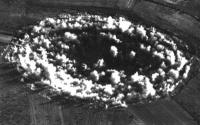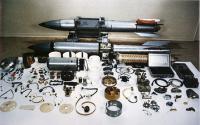-
Iran ships enriched uranium to Russia as part of nuclear deal

On Monday Iran took the most important step so far toward complying with the nuclear agreement it had signed with the P5+1 power by shipping 25,000lb of low-enriched uranium to Russia. Iran had until the end of 2015 to ship out all of its low-enriched uranium it has stockpiled – except 660lb which the agreements allows it to keep.
-
-
Pairing seismic data, radionuclide fluid-flow models to detect underground nuclear tests

Underground nuclear weapon testing produces radionuclide gases that may seep to the surface, which is affected by many factors. These include fractures in the rock caused by the explosion’s shock waves that create pathways for the gas to escape plus the effect of changes in atmospheric pressure that affect the gases’ movement. Scientists have developed a new, more thorough method for detecting underground nuclear explosions (UNEs) by coupling two fundamental elements — seismic models with gas-flow models — to create a more complete picture of how an explosion’s evidence (radionuclide gases) seep to the surface.
-
-
Design competitions needed to maintain U.S. nuclear deterrent
Preserving the U.S. nuclear weapon design skills is essential for sustaining a credible nuclear deterrent, understanding the status and direction of foreign nuclear weapons programs, and determining the best solutions to problems that arise during stockpile surveillance and maintenance. In the absence of nuclear explosion testing, the National Nuclear Security Administration (NNSA) should develop a series of design competitions that integrate the full end-to-end design process from novel design conception through production and non-nuclear testing of an engineered prototype, says a new report.
-
-
W80-4: Sandia California works on nuclear weapon Life Extension Program
Sandia National Laboratories is doing what it has not done in decades: extending the life of a nuclear warhead at the same time the U.S. Air Force develops a replacement cruise missile that will carry the weapon. The goal of the W80-4 Life Extension Program (LEP) is refurbishing the W80 warhead with replacement components for aging technology and components that have limited lifespans.
-
-
U.S. to clean up site of a 1966 nuclear weapons accident in Spain
On 17 January 1966, a B-52 bomber carrying four hydrogen bombs collided with a KC-135 tanker plane during mid-air refueling off the coast of Almería, Spain, killing seven of the eleven crew members. Two of the bombs were recovered intact from the sea, but the other two leaked radiation into the surrounding countryside when their plutonium-filled detonators went off, strewing 3kg of radioactive plutonium 239 around the town of Palomares. Following the accident, the U.S. military shipped 1,700 tons of contaminated soil to South Carolina, and the whole thing was forgotten. On Monday in Madrid, Secretary of State John Kerry and the Spanish foreign minister José Manuel García-Margallo, signed an agreement to clean up the site after tests showed that 50,000 cubic meters of soil were still contaminated.
-
-
U.S. tries to persuade Pakistan not to deploy small tactical nuclear weapons

Pakistani Prime Minister Nawaz Sharif is coming to the United States next week on an official visit, and ahead of the visit the Obama administration is holding talks with Pakistani officials about Pakistan’s plan to deploy a small tactical nuclear weapon which would be more difficult to monitor and secure than Pakistan’s arsenal of larger weapons. U.S. officials fear that the smaller weapons are easier to steal, or would be easier to use should they fall into the hands of a rogue commander. “All it takes is one commander with secret radical sympathies, and you have a big problem,” said one former official.
-
-
FBI helps foil several plots to sell nuclear material in Moldova’s black market
Over the past five years, four attempts by Russian gangs in Moldova to sell nuclear material have been thwarted by the FBI and Moldovan authorities. The most recent case was in February when a smuggler, who specifically sought a buyer from Islamic State, offered undercover agents a large amount of radioactive caesium. The would-be smuggler wanted €2.5 million for enough radioactive material to contaminate several city streets.
-
-
Upholding disarmament agreements with engineering
Arms control agreements face a problem: how to ensure that countries with nuclear weapons abide by disarmament agreements. The linchpin of these agreements is being able to verify that the signers are following the rules — but the trick is for both sides, or a third party, to be able to police weapons in a way that doesn’t give out too much information about them, for example, how these weapons were built. An MIT project, called Zero Knowledge Warhead Verification, tackles this problem with a beam of light, a scrambler, and a detector.
-
-
Nuclear weapons workers at DOE Texas plant vote to strike
Workers at Consolidated Nuclear Security Pantex in Amarillo, Texas are responsible for the nuclear weapons life extension programs; weapons dismantlement; development, testing, and fabrication of high explosives components; and storage and surveillance of plutonium pits. On Friday, after more than seven months at the bargaining table with CNS Pantex, 87 percent of the unionized workers at the Amarillo facility voted to strike.
-
-
What if it happened again? What we need to do to prepare for a nuclear event
As we observe the 70th anniversary of the bombings of Hiroshima and Nagasaki, it may seem like the threat from nuclear weapons has receded. But it hasn’t; the threat is actually increasing steadily. This is difficult to face for many people, and this denial also means that we are not very well-prepared for nuclear and radiological events. Any nuclear weapon exchange or major nuclear plant meltdown will immediately lead to a global public health emergency. The Ebola outbreak taught the world that we should have resources in place to handle a major health emergency before it happens. What would a Nuclear Global Health Workforce need to be prepared to manage? For that we can look back at the legacy of the atomic bombings of Hiroshima and Nagasaki, as well as the nuclear accidents like Chernobyl and Fukushima.
-
-
Leading U.S. scientists support Iran deal
Twenty-nine of leading U.S. scientists – among them Nobel laureates, nuclear weapons designers, and former White House and congressional science advisers – on Saturday sent a letter to President Barack Obama to express their support of the nuclear deal reached between the P5+1 powers and Iran, and to stress that in their professional assessment the deal “technically sound, stringent and innovative.” Most of the twenty-nine who signed the letter have held Q clearances, a top security clearance which grants its holders access to a special category of secret information related to the design of nuclear weapons. The scientists’ letter as describe as “without precedent” the deal’s explicit ban on Iran’s research on nuclear weapons “rather than only their manufacture,” as prescribed in the 1968 Non-Proliferation Treaty (NPT).
-
-
The Joint Comprehensive Plan of Action “kicks the can down the road”: How to prepare for the day when the can finally lands
The Institute for Science and International Security has published a series of briefs analyzing different aspects of the agreement reached between the P5+1 and Iran over the latter’s nuclear program. One brief deals with what the United States and the other world powers need to do now to prepare for what may happen in Iran in ten to fifteen years when many of the limits the agreement imposes on Iran’s nuclear activities will expire. The agreement does not prohibit Iran from building a large uranium enrichment capability and even a reprocessing, or a plutonium separation, capability. The agreement essentially delays the day when Iran reestablishes a nuclear weapons capability and possibly builds nuclear weapons, that is, the agreement essentially “kicks the can down the road.” Prudent planning requires careful efforts now to prepare for the day when the can lands.
-
-
Inspection regime in Iran informed by lessons from Iraq experience
Many critics of the agreement reached between the P5+1 and Iran over Iran’s nuclear program are especially concerned with the inspection regime negotiated in Geneva. The initial goal of the world powers was, in President Barack Obama’s words, an “Anywhere, anytime” inspections, but the deal finally reached saw the two sides agree to inspection procedures which fall short of that goal.
-
-
The science behind the deal
The main U.S. objective of the deal with Iran is to decrease the riskiness of Iran’s civilian nuclear program to a point which (1) future nuclear weapon production would be unlikely, and (2) if Iran does cheat, it would be detected with reasonable certainty. Have the objectives been achieved in the deal signed 14 July? It is important to keep in mind that it is not reasonable for opponents of the deal to demand 100 percent certainty in verifying the agreement and it is also not necessary. A cost-benefit analysis is always done to determine what is feasible. Often this is not understood, and unreasonable demands may be placed on the verification regime.
-
-
NNSA should consider more than one alternatives for lithium production: GAO
An isotope of lithium is a key component of nuclear weapons and is essential for their refurbishment. The National Nuclear Security Administration’s (NNSA) halted certain aspects of its lithium production operation — conducted at its Y-12 National Security Complex in Oak Ridge, Tennessee — in May 2013 due to the condition of the site’s 72-year old lithium production facility. Y-12 management concluded that usable lithium could run out without additional actions. In response, NNSA developed a strategy which proposed a new lithium production facility by 2025 and identified “bridging” actions needed to meet demand through 2025. GAO says that NNSA should give consideration to other alternatives for addressing the coming lithium production crunch.
-
- All
- Regional
- Water
- Biometrics
- Borders/Immig
- Business
- Cybersecurity
- Detection
- Disasters
- Government
- Infrastructure
- International
- Public health
- Public Safety
- Communication interoperabillity
- Emergency services
- Emergency medical services
- Fire
- First response
- IEDs
- Law Enforcement
- Law Enforcement Technology
- Military technology
- Nonlethal weapons
- Nuclear weapons
- Personal protection equipment
- Police
- Notification /alert systems
- Situational awareness
- Weapons systems
- Sci-Tech
- Sector Reports
- Surveillance
- Transportation
Advertising & Marketing: advertise@newswirepubs.com
Editorial: editor@newswirepubs.com
General: info@newswirepubs.com
2010-2011 © News Wire Publications, LLC News Wire Publications, LLC
220 Old Country Road | Suite 200 | Mineola | New York | 11501
Permissions and Policies
Editorial: editor@newswirepubs.com
General: info@newswirepubs.com
2010-2011 © News Wire Publications, LLC News Wire Publications, LLC
220 Old Country Road | Suite 200 | Mineola | New York | 11501
Permissions and Policies
